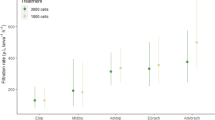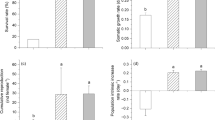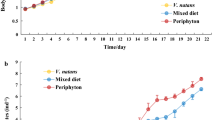Abstract
The life-history of the crown-of thorns starfish (Acanthaster planci) includes a planktotrophic larva that is capable of feeding on particulate food. It has been proposed, however, that particulate food (e.g. microalgae) is scarce in tropical water columns relative to the nutritional requirements of the larvae of A. planci, and that periodic shortages of food play an important role in the biology of this species. It has also been proposed that non-particulate sources of nutrition (e.g. dissolved organic matter, DOM) may fuel part of the nutritional requirements of the larval development of A. planci as well. The present study addresses the ability of A. planci larvae to take up several DOM species and compares rates of DOM uptake to the energy requirements of the larvae. Substrates transported in this study have been previously reported to be transported by larval asteroids from temperate and antarctic waters. Transport rates (per larval A. planci) increased steadily during larval development and some substrates had among the highest mass-specific transport rates ever reported for invertebrate larvae. Maximum transport rates (J max in) for alanine increased from 15.5 pmol larva−1 h−1 (13.2 pmol μg−1 h−1) for gastrulas (J max in=38.7 pmol larva−1 h−1 or 47.4 pmol μg−1 h−1) to 35.0 pmol larva−1 h−1 (13.1 pmol μg−1 h−1) for early brachiolaria (J max in just prior to settlement=350.0 pmol larva−1 h−1 or 161.1 pmol μg−1 h−1) at 1 μM substrate concentrations. The instantaneous metabolic demand for substrates by gastrula, bipinnaria and brachiolaria stage larvae could be completely satisfied by alanine concentrations of 11, 1.6 and 0.8 μM, respectively. Similar rates were measured in this study for the essential amino acid leucine, with rates increasing from 11.0 pmol larva−1 h−1 (or 9.4 pmol μg−1 h−1) for gastrulas (J max in=110.5 pmol larva−1 h−1 or 94.4 pmol μg−1 h−1) to 34.0 pmol larva−1 h−1 (or 13.0 pmol μg−1 h−1) for late brachiolaria (J max in=288.9 pmol larva−1 h−1 or 110.3 pmol μg−1 h−1) at 1 μM substrate concentrations. The essential amino acid histidine was transported at lower rates (1.6 pmol μg−1 h−1 at 1 μM for late brachiolaria). Calculation of the energy contribution of the transported species revealed that larvae of A. planci can potentially satisfy 0.6, 18.7, 29.9 and 3.3% of their total energy requirements (instantaneous energy demand plus energy added to larvae as biomass) during embryonic and larval development from external concentrations of 1 μM of glucose, alanine, leucine and histidine, respectively. These data demonstrate that a relatively minor component of the DOM pool in seawater (dissolved free amino acids, DFAA) can potentially provide significant amounts of energy for the growth and development of A. planci during larval development.
Similar content being viewed by others
References
Bass N, Chapman G, Chapman JH (1969) Uptake of leucine by larvae and adults of Nereis. Nature Lond 211:476–477
Birkeland C (1982) Terrestrial runoff as a cause of outbreaks of Acanthaster planci (Echinodermata: Asteroidea). Mar Biol 69:175–185
Brodie JE (1992) Enhancement of larval and juvenile survival and recruitment in Acanthaster planci from the effects of terrestrial run-off: a review. Aust J mar Freshwat Res 43:539–554
Crossland CJ, Barnes DJ, Borowitzka MA (1980) Diurnal lipid and mucus production in the staghorn coral Acropora acuminata. Mar Biol 60:81–90
Davis J, Bellis S, Stephens GC (1988) Characterization of a broadscope amino acid transport system in sand dollars. Am J Physiol 254:R485-R490
Davis JP, Stephens GC (1984) Uptake of free amino acids by bacteria-free larvae of the sand dollar Dendraster excentricus. Am J Physiol 247:R733-R739
Epel D (1972) Activation of Na+−dependent amino acid transport system upon fertilization of sea urchin eggs. Expl Cell Res 72:74–89
Ferrier MD (1991) Net uptake of dissolved free amino acids by 4 scleractinian corals. Coral Reefs 10:183–187
Fogg GE (1966) The extracellular products of algae. Oceanogr mar Biol A Rev 4:195–212
Gnaiger E (1983) Appendix 1. In: Gnaiger E, Forstner H (eds) Polarographic oxygen sensors: aquatic and physiological applications. Springer-Verlag, Berlin, p 337–345
Hoegh-Guldberg O, Manahan DT (1991) Metabolic requirements during growth and development of echinoderm larvae. Am Zool 31:p4A
Hoegh-Guldberg O, Welborn JR (1992) Appendix 1. In: Ayukai T, Hoegh-Guldberg O (eds) Assessment of the role of dissolved organic matter and bacteria in the nutrition of crown-of-thorns starfish larvae. Report to the Great Barrier Reef Marine Park Authority. Great Barrier Reef Marine Park Authority, Townsville, p 1–52
Jaeckle WB, Manahan DT (1989a) Amino acid uptake and metabolism by larvae of Urechis caupo (Echiura), a new species in axenic culture. Biol Bull mar biol Lab, Woods Hole 176:317–326
Jaeckle WB, Manahan DT (1989b) Feeding by a “non-feeding” larva: uptake of dissolved amino acids from seawater by lecithotrophic larvae of the gastropod Haliotis rufescens. Mar Biol 103:87–94
Johannes RE, Coward SJ, Webb KK (1969) Are dissolved amino acids an energy source for marine invertebrates? Comp Biochem Physiol 29:283–288
Langdon CJ (1983) Growth studies with bacteria-free oyster (Crassostrea gigas) larvae fed on semi-defined diets. Biol Bull mar biol Lab, Woods Hole 164:227–235
Lucas J (1982) Quantitative studies of feeding and nutrition during larval development of the coral reef asteroid Acanthaster planci (L.). J exp mar Biol Ecol 65:173–193
Manahan DT (1983) The uptake and metabolism of dissolved amino acids by Bivalve larvae. Biol Bull mar biol Lab, Woods Hole 164:236–250
Manahan DT (1989) Amino acid fluxes to and from seawater in axenic veliger larvae of a bivalve (Crassostrea gigas). Mar Ecol Prog Ser 53:247–255
Manahan DT (1990) Adaptations by invertebrate larvae for nutrient acquisition from seawater. Am Zool 30:147–160
Manahan DT, Davis JP, Stephens GC (1983) Bacteria-free sea urchin larvae: selective uptake of neutral amino acids from seawater. Science, NY 220:204–206
Manahan DT, Jaeckle WB, Nourizadeh S (1989) Ontogenic changes in the rates of amino acid transport from seawater by marine invertebrate larvae (Echinodermata, Echiura, Mollusca). Biol Bull mar biol Lab, Woods Hole 76:161–168
Manahan DT, Wright SH, Stephens GC, Rice MA (1982) Transport of dissolved amino acids by the mussel Mytilus edulis: demonstration of net uptake from natural seawater. Science, NY 215:1253–1255
Moran PJ (1986) The Acanthaster phenomenon. Oceanogr mar Biol A Rev 24:379–480
Moran PJ, Johnson DB (1991) Report on the progress of COTSREC ecological research: July 1989–February 1991. Australian Institute of Marine Science, Cape Ferguson, p 15–17 (The Crown of Thorns Study Report No. 12, May 1991)
Nobel PS (1983) Biophysical plant physiology and ecology. W. H. Freeman & Co., San Francisco
Olson RR (1987) In situ culturing as a test of the larval starvation hypothesis for the crown-of-thorns starfish, Acanthaster planci. Limnol Oceanogr 32:895–904
Reish DJ, Stephens GC (1969) Uptake of organic material by aquatic invertebrates. V. The influence of age on the uptake of glycine-C14 by the polychaete Neanthes arenacedentata. Mar Biol 3:352–355
Schlichter D, Liebezeit G (1991) The natural release of amino acids from the symbiotic coral Heteroxenia fuscescens (Ehrb) as a function of photosynthesis. J exp mar Biol Ecol 150:83–90
Shilling FM, Manahan DT (1994) Energy metabolism and amino acid transport during early development of antarctic and temperature echinoderms. Biol Bull mar biol Lab, Woods Hole (in press)
Welborn JR, Manahan DT (1990) Direct measurements of sugar uptake from seawater into molluscan larvae. J exp mar Biol Ecol 65:233–239
Williams PJ (1975) Biological and chemical aspects of dissolved organic material in sea water. In: Riley JP, Skirrow G (eds) Chemical oceanography. Vol. 2. Academic Press, New York, p 301–363
Author information
Authors and Affiliations
Additional information
Communicated by G. F. Humphrey, Sydney
Rights and permissions
About this article
Cite this article
Hoegh-Guldberg, O. Uptake of dissolved organic matter by larval stage of the crown-of-thorns starfish Acanthaster planci . Mar. Biol. 120, 55–63 (1994). https://doi.org/10.1007/BF00381942
Accepted:
Issue Date:
DOI: https://doi.org/10.1007/BF00381942




